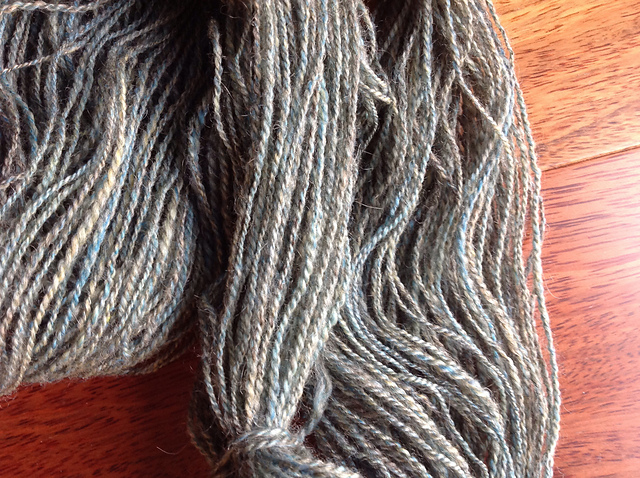The first fibre I spun was Hilltop Cloud Blue Tit which is a lovely blend from the Birds Series, and is comprised of 56% Merino/26% Shetland/16% Kid Mohair.
I started spinning this fibre on the Rakestraw but didn't get very far, as I got distracted when I got my first support spindle. I decided it was best to start again from scratch on the Tibetan, as it had sat, unloved, for so long. The resulting yarn is quite uneven and it is a two ply. It’s a fingering/sport weight, and I got 165 meters from the 80 grams I had left.
As I had started to look at some of my older fibre, I decided to tackle The Yarn Yarn Superwash BFL Blackcurrant Sorbet. I spun this fibre on the Lightweight Wildcraft Tibetan spindle,and decided to chain ply it. It's 157 meters of a sport weight and weighs 106 grams.
I love how plump and round the yarn is from doing a chain ply. It was well worth making the chain and creating a plying ball, before putting the twist into the fibre. This blog post from Studio Strategos shows quite clearly how to make a plying ball. I decided to use a plying ball, despite having a Lazy Kate, because it doesn't put tension on the singles when they are being plied. As a result it is hard to control the plying process. Putting balanced tension on the singles and winding them into a ball, creates a much more even plying process, with much fewer swear words.
When I did the KAL last year, Deb at Fondant Fibre, donated some prizes, but she also gave me a give of some matching Fondant Fibre Shetland Pink Gradient which was a colour that I wouldn't normally buy for myself. As such it was great fun to play with. I really enjoyed spinning this lovely bouncy fibre and I will definitely seek out Shetland fibre again. (93 grams, 135 meters)
I spun this fibre on the Medium Wildcraft Tibetan spindle. I decided to run with the bouncy nature of the fibre and spun quite thick and airy singles. Then I made a a two ply yarn that barber poled beautifully. It's soft and springy and a DK weight. The resulting yarn weighed 93g and measured 135m.
The good news about this fibre, is that there is some left to be won as a prize for someone on the blog or podcast in a few weeks time, as I am thinking about running a Spin-a-Long after the Ravellenics Games is out of the way. I'm actually running a Winter Warmer KAL (#stwwkal) over on the Ravelry Group, if you hadn't spotted it. It's a fast and easy KAL, requiring the completion a single Winter accessory. Come and have a look if you want a chance to win a prize, or just to see what people are making. Full details are available on this thread.
Next up was some fibre from All The Pretty Fibres, who are based in Germany. It was my first experience of spinning a batt.
I think I would have been more successful spinning it woollen style. However, as I have some more of this particular fibre, in a pretty green, I can actually try that experiment.
The resulting yarn is merino/silk and I got 238m of a fingering/4ply weight yarn. I spun it on my Wildcraft Medium Weight spindle and the yarn is 2-ply. I spun worsted which is the way I have spun most of my fibre up until now.
My first attempt at spinning woollen style, using long draw, gave mixed results. I used the embedded video to learn how to do woollen spinning using a supported spindle, as I found it quite hard to get my head around the techniques being demonstrated on spinning wheels and translating it to my supported spindles.
The woollen spun yarn was made using another blend by Hilltop Cloud called Jane Seymour, which is part of her Queen's series. The blend is made up of 50% Merino/25% Shetland/12.5% Milk Protein/12.5% Firestar and was nice and airy to start with, which made spinning it from the fold much easier. The resulting yarn is 150 metres, of sport weight yarn, made as a 2-ply using an Andean Plying Bracelet and it weighs 99g. I used a book and a chopstick as a tool based on a tutorial by Rosemary Knits to make the bracelet, rather than my hand.
As a first experiment into this new technique it wasn't a complete disaster and I do want to try again, maybe with some lovely punis I got from Fondant Fibre. The new issue of Ply Magazine is all about woollen spinning and I am slowly working my way through it. There was also a really interesting guest post over on Sarah's blog, by Alicia Landi, about the preparation for spinning in a woollen style, which I found really interesting. I am now beginning to think I would like to invest in some hand cards, to make the preparation for woolen spinning easier.
That does seem an awful lot of spinning that I forgot to tell you about. I hope you will forgive my tardiness in my big reveal! I will share this post with Sarah's spinning post over on Crafts from the Cwtch. Then maybe I should start thinking about how I can use this wide variety of yarns in such small quantities.







